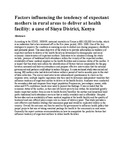| dc.description.abstract | According to the KDHS, 2008/09, maternal mortality in Kenya is 4881100,000 live births, which is an indication that is has worsen off in the five years period, 2003- 2008. One of the key strategies to improve the condition is ensuring access to skilled care during pregnancy, childbirth and postnatal period. The main objective of the study is to provide information on tendency of expectant mothers to deliver at the health facility as determined by demographic and socio economic characteristics of expectant mothers. Indicators to be monitored during the study include; presence of traditional birth attendance within the vicinity of the expectant mother, availability of basic medical supplies in the health facilities and economic status of the mother.
It is hoped that this study will inform the identification of factors that are responsible for the gap between antenatal and delivery attendance and propose effective intervention that the national government and partners could adopt to reduce this gap. A cross sectional study was carried out among 208 mothers who had delivered babies within a period of twelve months prior to the start of data collection.
The survey used interviewer administered questionnaire to check on the response rates, multiple logistic regression was then used to determine independent variables that influence tendency of expectant mother to deliver at the health facility. Analyses were conducted for secondary data and response from target population Frequencies, percentages, means, odds ratios and 95% confidence limits were used to present the findings.
It was revealed that the economic status of the mother, in this case life below poverty line within the household greatly hinder expectant mother from access to health facility therefore the mother and household head prefer traditional birth attendance services that is readily available and is affordable. Hospital factors also such as availability of basic medical supplies at the health facility and the quality of treatment and care offered play a major role in choice of delivery point.
This study provides a cost-effective and feasible strategy that minimizes gaps and would be replicated widely in the country. Overall the outcome can then be used by the government to influence health policy that propel projects that aim at taking essential package for health to the community in rural areas. Generally the report contains recommendation on how to manipulate the predictor factors that influence tendency of expectant mothers to utilize health facilities. | en_US |

